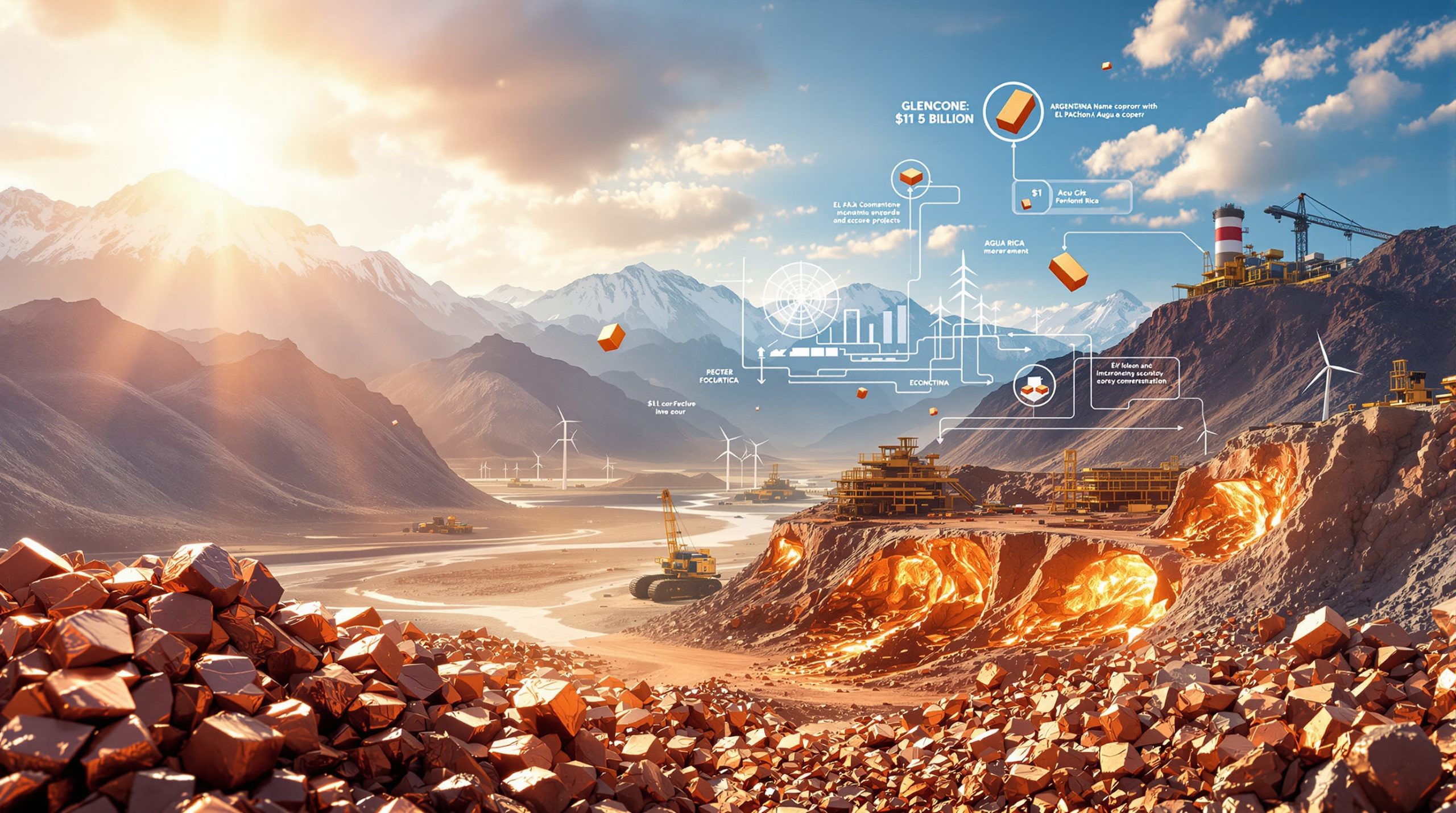Resolution Copper Project: Regulatory Challenges and Mining Industry Impact
The Resolution Copper Project stands at a critical crossroads, positioned to potentially become North America's largest copper mine while simultaneously facing significant regulatory, environmental, and cultural hurdles. This long-delayed mining venture highlights the complex balance between resource development, indigenous rights, and environmental protection in America's mining sector.
What is the Resolution Copper Project?
The North American Copper Giant
Located near Superior, Arizona, the Resolution Copper Project targets a rich porphyry copper deposit buried deep beneath the former Magma Mine site. This massive underground resource extends 5,000-7,000 feet (1,500-2,130 meters) below the surface, making it one of the deepest mining operations proposed in North America.
The deposit's resource estimates exceed 1.6-1.7 billion tonnes with approximately 1.5% copper grade, representing one of the most significant undeveloped copper resources in the world. If developed, projections suggest the mine could produce approximately 40 billion pounds of copper over a 40-year operational lifespan.
At full capacity, the Resolution Copper Project could potentially satisfy up to 25% of the US copper production overview, providing a significant boost to domestic mineral supply chains at a time when copper's importance in modern infrastructure is growing exponentially.
Strategic Importance to U.S. Copper Supply
Copper's role as a critical mineral has expanded dramatically with the growth of renewable energy technologies, electric vehicles, and modern electronics. The metal's exceptional electrical conductivity makes it irreplaceable in numerous applications:
- Electrical systems and power transmission infrastructure
- Solar panels and wind turbine components
- Electric vehicle batteries and charging systems
- Electronics and telecommunications equipment
The development of domestic copper resources has gained strategic importance as the U.S. seeks to reduce dependency on imported minerals and strengthen supply chain resilience. The Resolution Project represents a significant opportunity to address these concerns while potentially creating thousands of jobs and generating substantial economic activity in Arizona.
Why Has the Project Faced Continuous Delays?
Regulatory and Permitting Hurdles
The Resolution Copper Project has navigated a complex regulatory landscape since its inception as a joint venture between mining giants BHP and Rio Tinto in 2004. Perhaps the most significant hurdle has been the requirement for a land exchange with the federal government.
The copper deposit lies partially beneath federally owned land, necessitating Congressional approval for a land swap. This exchange was eventually included in the 2015 National Defense Authorization Act, which mandated trading 2,400 acres of federally protected land for 5,300 acres of private land owned by the mining companies.
Despite receiving "Fast-41" priority status designed to expedite federal approvals for infrastructure projects, the Resolution Copper Project has continued to face delays through multiple environmental impact assessments and reviews. The permitting process has stretched across multiple presidential administrations, with shifting priorities and policies further complicating the timeline. Recent discussions about a regulatory permitting order could potentially impact the project's advancement.
Indigenous Opposition and Cultural Concerns
At the heart of opposition to the Resolution Copper Project lies Oak Flat, known to the Apache as "Chi'chil Biłdagoteel." This area holds profound cultural and religious significance for the San Carlos Apache Tribe and other indigenous communities.
The Oak Flat area contains:
- Sacred ceremonial grounds used for generations
- Significant archaeological sites dating back centuries
- Rare Emory oak trees harvested for traditional acorn-based foods
- Burial sites and other culturally significant locations
The proposed mining operation would utilize block cave mining, which would eventually result in the surface collapsing to form a crater approximately 1,000 feet deep and 2 miles across. This subsidence would permanently alter the landscape, effectively destroying the Oak Flat area as it exists today.
Indigenous groups and environmental organizations have filed multiple legal challenges to protect this culturally significant land, creating a series of legal barriers that have significantly delayed the project's advancement.
What's the Latest Setback for Resolution Copper?
Recent Legal Developments
The Resolution Copper Project appeared to gain momentum when the U.S. Supreme Court declined to hear a formal appeal in May 2025, seemingly clearing a path for the land exchange to proceed in August 2025. However, this apparent breakthrough was short-lived.
In a significant legal development, the 9th Circuit Court of Appeals issued a temporary block on the land transfer following a successful injunction request by a coalition of environmental organizations and tribal groups. This latest legal obstacle represents yet another delay in the project's long and contentious history.
Resolution Copper representatives have expressed confidence that this pause is temporary, characterizing it as a procedural delay rather than a fundamental obstacle to the project's eventual approval. However, the continuation of legal challenges suggests that additional delays may lie ahead as the courts consider the merits of opposition arguments.
Political Dimension
The Resolution Copper Project has become increasingly politicized, with mining policy positions often falling along partisan lines. The Trump administration adopted a pro-mining stance that created optimism among project supporters for advancement of the necessary approvals.
Recent presidential comments on social media regarding the latest delay characterized opposition to the project as "anti-American" and potentially influenced by competing copper interests. These statements highlight the tension between economic development priorities and indigenous rights protection.
The politicization of the regulatory process adds another layer of complexity to an already challenging approval pathway. As administrative priorities shift between presidential administrations, the Resolution Copper Project faces an uncertain regulatory future dependent in part on which political party controls key decision-making positions.
How Would the Mine Operate Once Approved?
Technical Mining Approach
The Resolution Copper Project proposes utilizing block caving techniques, a form of underground mining particularly suited to large, low-grade ore deposits. This method involves:
- Drilling tunnels beneath the ore body
- Creating a network of extraction points
- Undercutting the deposit to initiate controlled collapse
- Allowing gravity to break apart the ore
- Collecting fragmented ore through draw points for processing
This technical approach requires extensive infrastructure development before production can begin, including shaft construction, ventilation systems, and underground tunnel networks. Industry experts estimate that multiple years of preparatory work would be necessary following final approvals before copper production could commence.
The depth of the deposit necessitates sophisticated mining techniques, with operations extending more than a mile below the surface. This presents significant technical challenges related to ground control, ventilation, and worker safety that must be addressed through advanced engineering solutions.
Processing Challenges
Beyond the extraction challenges, the Resolution Copper Project faces significant hurdles in processing the extracted ore. The United States currently has limited domestic copper refining capacity, with only three operational copper smelters in the country—two in Arizona and one in Utah.
This processing bottleneck creates several strategic considerations:
- Initial refining would likely occur overseas, primarily in China
- Processed copper returning to U.S. markets could face tariff implications
- Long-term need exists for expanded domestic processing capacity
- Value-added processing steps would occur outside U.S. economic sphere
- Supply chain vulnerability increases with international processing
The limited domestic refining capacity represents a significant challenge for the project's ability to strengthen U.S. mineral security, as extracted copper would need to be shipped internationally for processing before returning to American markets as finished products.
What Does This Mean for BHP and Rio Tinto?
Short-Term Investment Impact
The continued delays have limited immediate financial impact on both BHP and Rio Tinto, as both mining giants maintain diverse global mining portfolios that mitigate the effect of delays in any single project. However, the Resolution Copper Project represents a significant long-term investment with increasingly delayed returns.
Both companies have allocated substantial capital to maintain project readiness while navigating the regulatory process. This creates investor uncertainty regarding the timeline to production and ultimate return on investment. The extended timeline also increases the risk profile of the project as market conditions and copper price decline analysis shows fluctuations over time.
Key financial considerations include:
- Ongoing holding costs during regulatory delays
- Potential increases in development expenses due to inflation
- Shifting market conditions affecting long-term copper price predictions
- Opportunity costs of capital tied up in a non-producing asset
- Increasing risk premium expected by investors for project advancement
Strategic Considerations
Industry analysts suggest the Resolution Copper Project is approaching a critical decision point described as a "very soon or never" development timeline. With each delay, the regulatory costs increase, creating pressure to either advance quickly or potentially abandon the project entirely.
The mining companies must balance shareholder expectations with project development realities while considering long-term copper market positioning. As global demand for copper continues to grow with renewable energy adoption and electrification trends, the strategic value of large copper deposits is increasing.
The Resolution Project also represents a potential precedent-setting case for future mining projects on contested lands. How BHP and Rio Tinto navigate indigenous relations, environmental concerns, and regulatory hurdles could establish patterns for resource development across the industry.
What's the Future Outlook for Resolution Copper?
Potential Pathways Forward
Several potential pathways could determine the future of the Resolution Copper Project:
-
Expedited appeal process – Resolution Copper could pursue an accelerated legal timeline before the 9th Circuit Court, potentially resolving the current injunction.
-
Legislative intervention – Congress could pass legislation to clarify land exchange requirements or expedite approvals, though this would require significant political support.
-
Stakeholder engagement – Continued dialogue with indigenous communities could potentially identify compromise solutions, though previous attempts have yielded limited progress.
-
Alternative mining approaches – Technical innovations might reduce environmental impact, though the deposit's characteristics limit options.
-
Economic reassessment – Changing market conditions and extended timelines may trigger a fundamental reevaluation of project economics.
The most likely outcome involves continued legal proceedings and regulatory review, potentially extending the timeline by additional years before a final determination is reached.
Broader Industry Implications
The Resolution Copper Project serves as a test case for balancing critical mineral needs with indigenous rights and environmental protection. The ultimate resolution will likely set precedents for future mining projects on culturally significant lands throughout the United States.
The project also functions as an indicator of America's ability to develop domestic critical mineral resources at a time when supply chain security has become a national priority. The challenges faced by Resolution Copper highlight the complex regulatory landscape for mining projects in the United States compared to other major mining jurisdictions.
For the broader mining industry, Resolution Copper offers a potential blueprint for stakeholder engagement in controversial resource developments. The successes and failures in managing indigenous relations, environmental concerns, and community impacts will likely influence approaches to similar projects globally, including mine reclamation innovations for future sites.
FAQ: Resolution Copper Project
How much copper could Resolution Copper produce annually?
The Resolution Copper Project is projected to produce approximately 1 billion pounds of copper annually once fully operational. This output would represent about 25% of current U.S. copper demand, significantly reducing American reliance on imported copper.
This production capacity is equivalent to several smaller mines combined, making Resolution potentially the largest single copper producer in North America. The mine's output would support numerous downstream industries, from electrical infrastructure to renewable energy manufacturing.
Note: Production projections are based on current resource estimates and would be subject to final mine planning and operational considerations.
Why is the Oak Flat area so controversial?
The Oak Flat area has been designated as a Traditional Cultural Property in the National Register of Historic Places, reflecting its profound significance to indigenous communities. The site contains numerous archaeological locations dating back centuries, providing physical connections to ancestral practices and history.
For the San Carlos Apache Tribe and other indigenous groups, Oak Flat serves as an irreplaceable gathering place for traditional ceremonies and cultural practices. The area is also home to rare Emory oak trees used for traditional food gathering, adding nutritional and cultural importance to its preservation.
The mining operation's projected subsidence would permanently alter this landscape, creating a situation where cultural preservation and resource development appear fundamentally incompatible. This creates a classic conflict between economic development and cultural heritage that has no simple resolution.
What economic benefits would the project bring?
Proponents of the Resolution Copper Project highlight several projected economic benefits:
- Creation of approximately 3,700 direct and indirect jobs
- Estimated $61 billion in economic impact over the mine's operational life
- Significant tax revenue generation for local, state, and federal governments
- Infrastructure development in rural Arizona communities
- Potential downstream manufacturing growth in copper-dependent industries
These economic benefits must be weighed against environmental impacts, cultural considerations, and the long-term sustainability of mining-dependent economic development. Communities near mining operations often experience boom-and-bust economic cycles that create long-term planning challenges.
Could alternative mining methods be employed?
The block caving method was selected for the Resolution Copper Project due to the deposit's depth and geological characteristics. This approach offers economic viability for extracting lower-grade ore bodies at significant depths, but comes with surface subsidence impacts.
Alternative extraction methods generally prove less economically viable for this specific deposit type and location. While ongoing research explores more environmentally sensitive extraction techniques, the fundamental challenge remains balancing economic viability with environmental protection.
Some technological innovations might reduce certain impacts, but the basic reality of extracting large mineral deposits inevitably creates environmental change. This presents a central challenge for all mining projects: how to obtain necessary resources while minimizing harm to existing landscapes and communities.
Want to Spot the Next Major Copper Discovery Before the Market?
Discovery Alert's proprietary Discovery IQ model instantly identifies significant ASX mineral discoveries, delivering real-time alerts on potentially transformative opportunities like the next Resolution Copper. Visit our discoveries page to understand how major mineral discoveries can generate substantial returns and begin your 30-day free trial today.




